1
Smart Cities as the Prototype of the Intelligent Internet of Things
1.1 Overview
The Intelligent Internet of Things (IoT) is in the process of development. Many advances in this smart interactive human environment are already established. Many others are still to come. Significant visionary concepts have been floated, resulting in a general weariness with the hyperbole inherent in such futuristic concepts. This should not obscure the serious advances that have been made and are still to come. This chapter will attempt to envision the future while concretely treating current developments in smart IoT and near term future trends.
1.2 Smart Cities
The Intelligent Internet of Things is most developed in the urbanized areas of the developed countries where efficient networks for commerce, transportation, public utilities, residences, and life essentials are well developed as a matter of necessity.
An overview of these smart networks as currently envisioned can be framed by the concept of the smart city, as indicated in Figure 1.1.
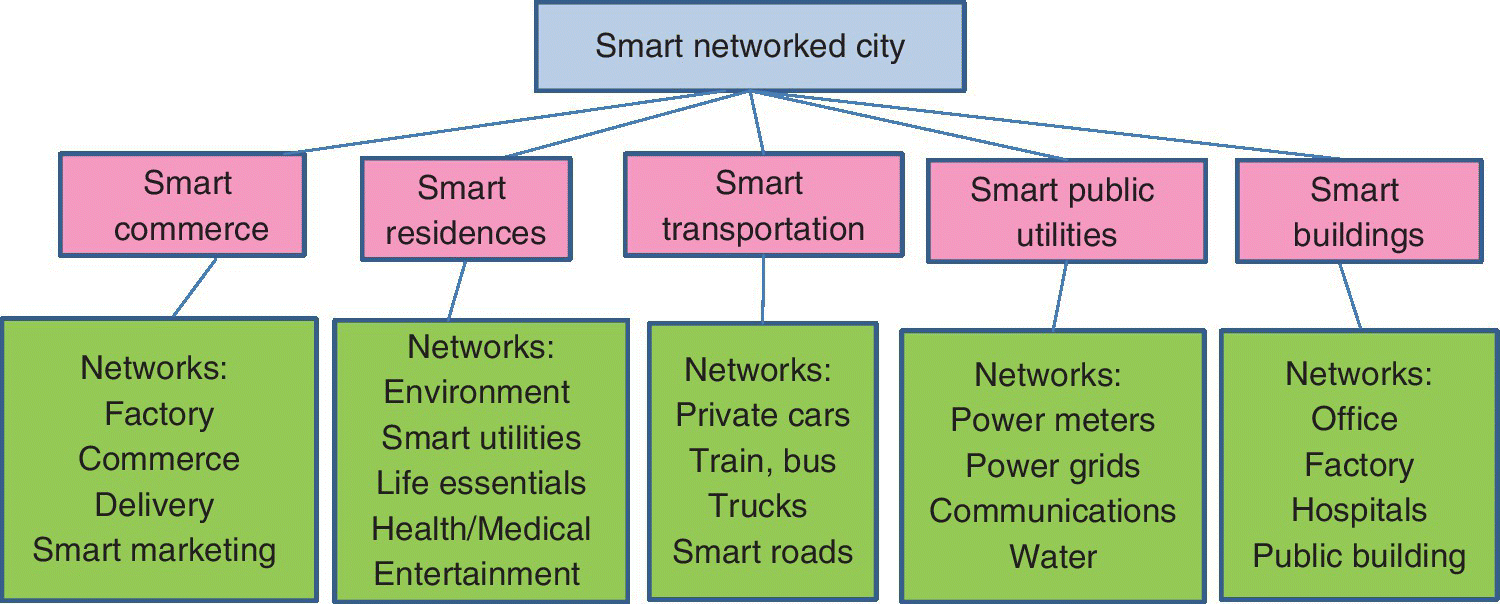
Figure 1.1 Elements of the smart city include connected networks of transportation, commerce, public services, connected residences, and public utilities.
Many of the networks used by people can be thought of as elements of the smart city. These include: networks of modes of transportation, commerce, services, residences, and public utilities.
1.3 Smart Commerce as an Element of the Smart City
1.3.1 Smart Inventory Control
The original inventory control tag was the bar code, which offers basic inventory data in a machine readable form and works by varying the widths and spacing of parallel lines. Following after the bar code was the QR Code optical label, which includes information about the item to which it is attached. The QR Code offers fast readability, more information than a bar code, and can be read with a smart phone. It often leads to a web page with product information.
Smart commerce began with the early machine‐to‐machine (M‐to‐M) communication devices. Early radio frequency identification (RFID) tags were used in factory and retail inventory, as shown in Figure 1.2. Unique ID codes could be stored locally and later in the cloud. The origin of the devices along with their manufacturing and transit history and even environmental influences could be saved and transmitted when needed. Prices could be fixed, stored, and changed locally.

Figure 1.2 RFID tag on retail merchandise showing antenna and chip.
Photo by B. Prince.
While RFID was an early implementation of a communications protocol, other remote communication protocol standards have been developed such as: near field communications (NFC) and Bluetooth. Communications protocols such as USB, SPI, and I2C are used within a connected system. WiFi is also used to connect electronic devices to a wireless local area network (WLAN) using specific frequencies.
Within a retail environment, tagged inventory as small as an individual item can be tracked, priced, and repriced and environmental information measured and stored. For example, sensors with thermal detectors can track the environment of an expensive wine or a medicine to be sure that it has been held within permitted temperature ranges.
1.3.2 Smart Delivery
Scheduled delivery has become an everyday reality, with on‐line stores routinely making timely deliveries with networks of agents using interconnected reporting systems. Delivery drones are not yet an everyday occurrence but pilot studies are being conducted. Amazon, in December of 2016, indicated it had delivered its first package by drone to a customer in Cambridge, England, using a drone with a range of 10 miles and a maximum load of 5 pounds [1]. An illustration of a commercially available drone carrying a camera and a control unit is shown in Figure 1.3.
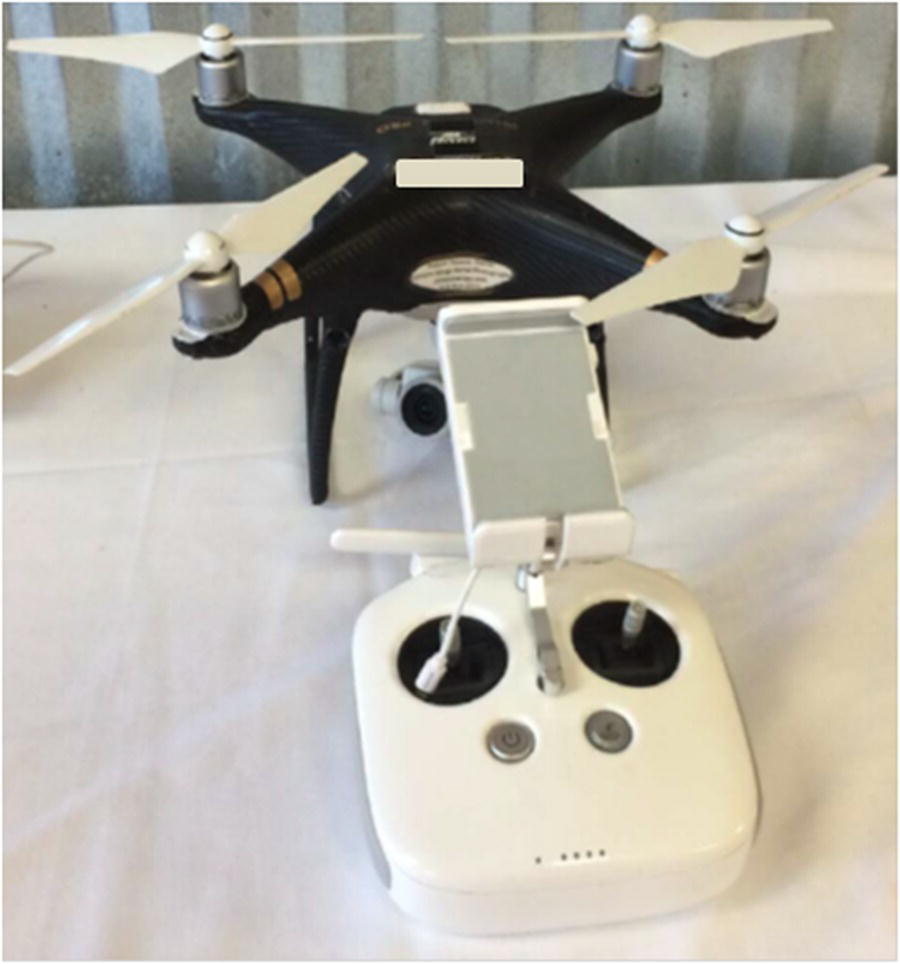
Figure 1.3 Drone carrying camera with control unit.
Photo by B. Prince.
1.3.3 Smart Marketing Using Artificial Intelligence
Artificial Intelligence can survey individual historical interests and purchases, and can predict consumer preferences. Smarter tags with transmit capability, called “Beacons,” can be used to lure potential buyers with targeted advertisements to their cell phones. These smart tags can also be used for tracking mobile objects in a controlled environment with the use of stationary tracking beacons.
1.4 Smart Residences
1.4.1 A City of Smart Connected Homes
IoT for Intelligent homes potentially includes: environmental control, external access and safety control, vision systems, light control, comfort control (auto adjusting beds and chairs), information control, entertainment control, health and medical alert, food and water control, safety alerts (tornado, fire, flood), animal access and care, and child monitoring and care. Initially remote control of these systems can be provided to the owner. Eventually such systems will be automated and robotic with owner access on demand. An illustration of the concept of a smart connected home is shown in Figure 1.4.

Figure 1.4 Concept of an intelligent connected home.
In the intelligent home, a controller device can be the owner’s mobile handheld computer (smartphone), which can be used to monitor the smart devices and provide control as modifications to the settings are desired. Normally, intelligent home sensors would be expected to function automatically without the need for human intervention.
An automated home could be expected to use the GPS locator in the owner’s phone to anticipate his/her arrival and biological inputs to secure entry. In the owner’s absence, thermostats would be expected to maintain temperatures at timed preset levels. The thermostat setting could be adjusted remotely from the resident’s smart phone. When the house is occupied, wearable monitors on the residents could communicate with the thermostat to adjust the light and comfort level for the residents automatically. Minithermostats that control a network of air conditioners could be used to individualize the temperature to the location and requirements of individual users. Light sensors could open and close shades at appropriate times and turn on outside lights as required and these could also be controlled and programmed on demand. Domestic appliances can be turned on and off remotely by either the owner or by a preset controller in the home network.
A smart refrigerator network, illustrated in Figure 1.5, could detect the condition and amount of each item from smart tags on the items and transmit an automated grocery list to the store [2]. The store in turn could find the requested items and have them either ready for pick‐up or delivered to the home.
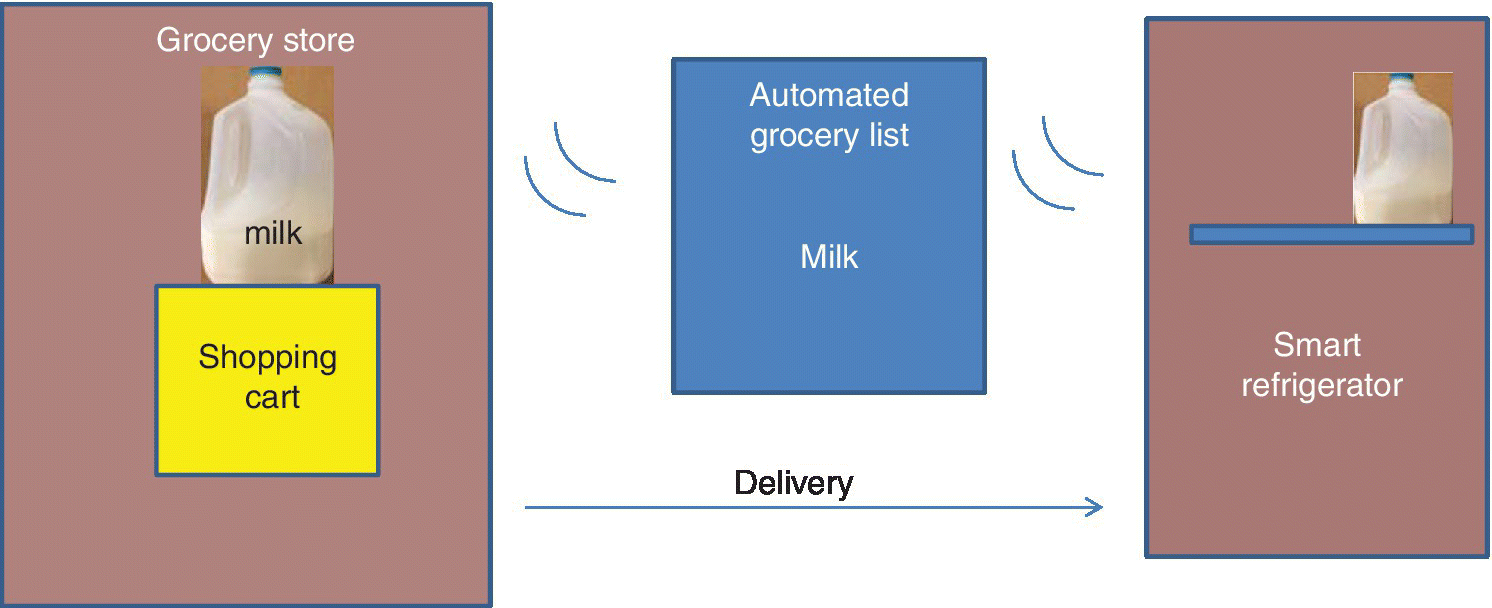
Figure 1.5 Example of transmitted autofill of grocery list using sensors for a low milk level, NFC for transmission of milk to a grocery list, WiFi for transmission of purchase request to grocery store, followed by delivery of milk to the home.
Autonomous systems using smart meters can monitor electrical usage and adjust flexible electrical equipment run times to correspond to lower cost energy times. Motion sensors can maintain security. Appropriate devices for implementation of these features are available today. Further out in time, the health and diet of the residents could be monitored, along with the quantity of nutritional elements in the house and grocery shopping lists could be automatically refilled [2].
1.5 People as Center of Smart Connected Homes
1.5.1 Wearable Electronics
The people in the smart homes can become another center for an Intelligent Internet of Things. Wearable exercise and health monitoring electronics can potentially form such a network. At its simplest, wearable electronics are machine‐to‐machine networks. Sensors worn on the body record a parameter such as heart rate or temperature and these measurement data are recorded and transmitted to a device that monitors and records the reading, such as a smart phone. The information could also be transmitted on to health professionals, with automated advice or prescription delivery being returned.
An example of intelligent connected wearable electronics is a system that senses, records, transmits, analyzes, instructs, and enables a response that could be by either a person or a device. An example is a wearable blood glucose detector associated with a wearable insulin pump and an analysis device. This glucose detector could measure and record the user’s blood glucose level and report it to the recording and analysis (R&A) device, which could be an application in a smart phone. The R&A device could note the glucose level and compare it to an acceptable level. If it is above a certain level, the R&A device could communicate with an insulin pump, which would inject a determined amount of insulin into the blood. Such a wearable glucose detector is available today as well as a wearable insulin pump that can be combined with the glucose detector [3–5]. Both can be worn as armbands, as indicated in Figure 1.6. Other smart wearable devices might include enhancements of normal bodily functions such as radar added to vision or color enhancement of sound.

Figure 1.6 Illustration of a possible future wearable system – a wearable blood glucose detector network with an intelligent monitor and connected insulin pump.
Wearable electronics are an example of systems that require very low standby power since the wearable devices are either powered by small coin cell batteries that provide a low current and can last a significant amount of time or are powered by some form of energy harvesting. These systems require ultralow power microcontrollers with embedded memory that is both nonvolatile for low standby power and has low operating power requirements.
1.5.2 Control Electronics
The home resident can be expected to have available simple automated control for all the functions of the home, whether they are in the home or away. This control is already available for many features such as cameras, lights, curtains, safety monitors, and alarms. Control of appliances and utilities is not far behind. All of this will be exercised from a handheld or worn device, currently a smartphone.
1.6 Smart Individual Transportation
1.6.1 Overview of Smart Automobiles
Automobiles are another example of an Intelligent Network of Things application. There are over 100 microcontrollers in the modern high end automobile [6]. These microcontrollers tend to fall into the classifications of: body processors, infotainment processors, driving aids, and engine processors, as shown in Figure 1.7 [6].
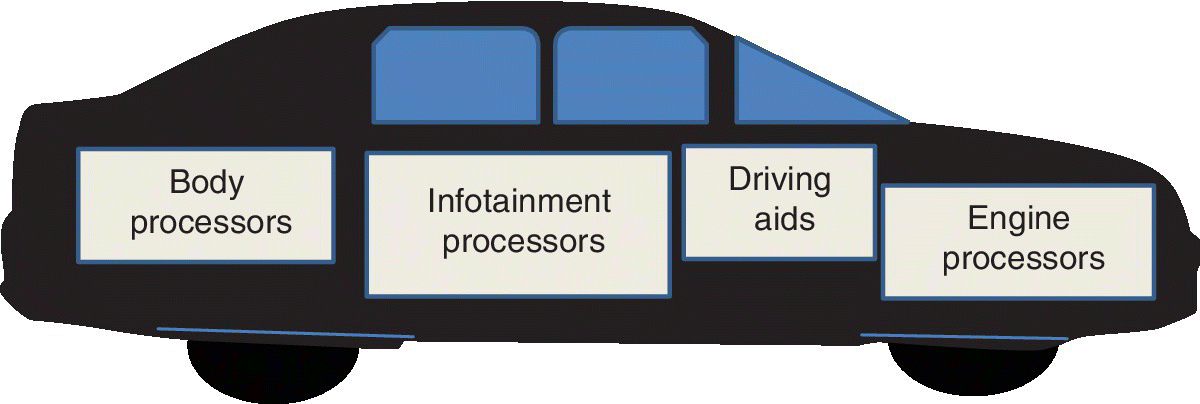
Figure 1.7 Automotive IoT networks of processors including: body processors, infotainment processors, driving aids, and engine processors.
Based on T. Kono et al. (Renesas), IEEE Journal of Solid‐Sate Circuits, January 2014 [6].
1.6.2 Driving Aids
An early example of a smart application driving aid is “anti‐lock” braking in a car in which wheel speed sensors can detect if one or more wheels are beginning to lock up during braking. If a wheel tries to lock up, a series of hydraulic valves limit braking on that wheel and initiate a pumping action, which helps stop the car safely without skidding in a minimum amount of time.
Another example of a smart IoT application that is a driving aid might be a back‐up camera or radar that detects an obstacle in the path of the car and notifies the braking system to apply the brakes, a lane change warning device, or a blind spot warning. Such systems exist today along with traction control, cruise control, and collision avoidance systems. Some systems currently readily available are shown in Figure 1.8.
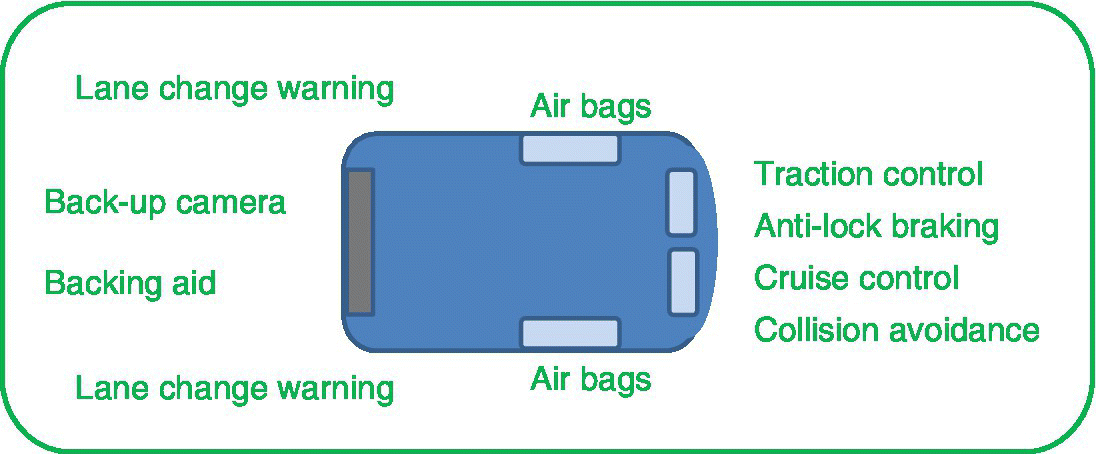
Figure 1.8 Automotive safety assistance devices currently available.
Driver‐assisted applications are being developed that can increase the knowledge of the driver of hazards, road conditions, and unseen traffic and also increase the driver’s skill at dealing with these traffic environment conditions. Examples include cameras and radar mounted on the car, which expand the driver’s knowledge of the immediate surroundings of the car on all sides at any given time. They also include automatic parking systems and automatic trailer back‐up systems.
The feedback to the driver from a driving aid must be fast, instantly understandable, unambiguous, and the response required obvious or autonomous. This requires fast sensors along with audiovisual aids, which would normally require fast processing and significant amounts of memory. High performance graphics processors could be used to implement these driving aids.
1.6.3 Engine Processors
Engine Control Units control an electrical system for a driving function in an automobile. These can include systems that control: power train, power steering, transmission, or engine timing. The inputs to the engine processors come from various sensors, which are primarily for engine management and performance. The Engine Processors tend to function autonomously without the requirement for driver intervention, providing primarily driver notification. For example, the failure of one of the engine sensors may result in the “check engine” light coming on as a driver notification aid. Primary criteria include performance at high temperature and high reliability. Since the engine of a car becomes hot, electronic components that will be expected to function properly in the engine compartment have temperature requirements for functionality that is generally –40 °C to +150 °C, but could be as high as 170 °C.
1.6.4 Auto Body Processors
Body processors can include: seat control units, automatic lock controllers, door modules, seat modules, central body, vehicle body, smart junction box, mirror adjust, air conditioning, lighting, seat belt sensors, and air bag controllers. These processors would be expected to include nonvolatile memories in some cases up to MBs in capacity. Air bag controllers would require fast response times. Security features are being added on these intelligent body processors.
1.6.5 Infotainment Processors
Visual information processors are critical for automobiles to reduce accidents at current high highway speeds by aiding drivers and enhancing their awareness of the external and internal environment of the car. Automotive projection systems with very wide fields of view that enhance driver vision both during the day and at night are in development. Such an optical system could include speed, navigation, obstacle awareness and avoidance, nighttime radar visual enhancement, and field of view enhancement for the driver of the car.
Parking assistance is another driver support system being developed. Such a system can use multiple cameras with 360 degree views and audible proximity sensors to aid in the parking process, or parking the car can be fully automated. Parking assistance of trailers is even available.
High performance GPS multisatellite navigation systems including complex destination guidance with both audio and visual displays are also in development. The current ease of integration of the smartphone into the automotive infotainment system offers connection between the vehicle and the Internet.
1.6.6 Autonomous Cars
Autonomous cars are in various stages of development, which would take the environmental conditions notification and act on these automatically. Fully autonomous driving would require considerations of priorities, which could be that value judgment cars would require artificial intelligence to analyze and act on. Criteria for an application such as smart brakes are fast sensing and speed of processing, since the brakes need to be applied before the accident occurs. Inputs to an automated braking system could be either input from cameras mounted on the car or from radar, both of which sense obstacles. In driverless applications the automobile is handled by a computer, which intakes information about the road conditions and drives the car to avoid obstacles and arrive at the intended destination.
The automobile network is an example of a system that does not necessarily have an ultralow power standby requirement since the various processors are on the car battery. High performance MCUs are required, however, for speed, both of processing and of read and write functions.
It is possible that traffic would be safer if autonomously driven cars and driver controlled cars are not driven in the same lanes or on the same highways. Perhaps initially internal city areas could be reserved for autonomous cars, which are generally available for hailing upon entering these areas. Alternatively, conventional public transportation networks could be expanded for city centers.
1.7 Smart Transportation Networks
1.7.1 Smart Public Conveyance Networks
Networks of public transportation such as trains and buses are also examples of smart transportation that can be run by M‐to‐M. Trains can be run automatically to preset schedules. Trains can have sensors either on the train or on the track that detect other trains and adjust speed to avoid collisions. Smart networks of trains would have programmed priorities and adjust travel speeds and routes to achieve the priorities of the smart network. Smart controllers could run an entire network with only local human monitoring.
1.7.2 Individual Automotive Traffic Control
Smart cards for ticketing have been used for years and toll tags mounted on the windscreen of a car are also in widespread usage. These tags can be polled remotely. The EZ tag system used in Texas is an example [7]. In this case users receive a small radio frequency (RFID) transponder which is affixed to the inside of the windshield of their car, as shown in Figure 1.9. When passing through a toll reader, specially equipped sensors can read EZ TAG transmitters and the amount stored on the card can be decremented after each use and incremented when recharged with money at a terminal.

Figure 1.9 Photograph of a Texas EZ tag RFID sticker affixed to a windshield.
Photo by B. Prince.
The tags can also be used to generate real time traffic information for use by the general public. The individual customer information is not exposed since the data taken is general traffic density and motion.
It is conceivable that such a system could be used to locate all residents of an area monitored by compatible sensors at a given time since the EZ tags do ID the specific automobile. This would depend on their being a sufficient density of sensors to detect all vehicles on the roadways in a specific area. Such a system could also be used to determine the speed of a particular vehicle by noting the time elapsed between successive tag readings.
1.7.3 Smart Highways
Smart highways should be able to coordinate traffic to ensure the smooth flow of traffic and ensure that traffic jams are eliminated and individual vehicles can safely reach their destinations in a minimum amount of time. Traffic light coordination is not unusual, but it should be flexible to accommodate the existing traffic configuration. Highway direction can also be changed depending on the time of day so that traffic in the dominant direction has more lanes. A different amount can be charged for access to high speed lanes, ensuring that each vehicle has the option of moving at a user determined rate. Sensors along the road should be able to sense the presence of cars and determine their speed by calculating the time between successive readings. The highway could help determine traffic safety by sensing speed and location of individual vehicles and communicating with each vehicle to ensure that vehicles maintain a minimum separation from each other.
Elevated and underground roadways are used to expand the amount of lane space over that available on a flat plane and were used, for example, on the Boston Dig and in many other cities. Limited access to freeways provides a smoother flow of traffic as do metered entrance ramps on to freeways. Accident detection systems can minimize the amount of time average speed is reduced due to an accident. They could also notify authorities of the occurrence of an accident and determine the vehicles involved and the ID of possible witnesses. Toll tag systems throughout the United States detect and identify a car containing a tag when the car passes a roadmark sensor.
1.8 Smart Energy Networks
1.8.1 Smart Electrical Meters
Electrical meters can connect the user to the electric utility to receive energy and determine its cost. It can connect to the devices in a smart residence or commercial building to determine essential systems and reduce electrical usage of nonessential systems during times of high energy cost or shift power usage by essential systems to lower the cost times of day. If electrical energy is available at the specific location, such as a rooftop solar array, the smart meter can route this additional energy into the electrical grid during peak energy usage times. Energy is produced by local solar systems during the hottest hours of the day when usage by air‐conditioning systems is highest. This could help reduce the amount of higher cost energy required during these peak hours. Electrical energy in and out of a specific location can be tallied by a smart meter.
Datalogging of electricity usage by a smart meter can be done frequently. The data for conventional smart meters is usually logged to a serial EEPROM due to its low cost, low power, and standard package. The advent of “advanced metering infrastructure” (AMI) meters promotes efficient electrical power generation, transmission, and distribution. Smart e‐meters can log electric power parameters as frequently as every few seconds or even in millisecond intervals. With frequent datalogging the performance of the meter is impacted by the slow nonvolatile memory write speed and limited endurance cycles. For this reason alternative memory technologies, such as ferroelectric RAMs, battery backed SRAM, and nonvolatile SRAM, have been used in AMI smart meters. These memory options tend to have higher endurance and a faster write speed [8].
Smart meters can be connected to energy consuming devices in a building with instructions to take these devices off‐line during peak energy times when electricity demand and prices are highest and the system is most at risk for rolling blackouts. This both saves money for the building owner and helps the electric utility avoid blackouts. Security is a significant issue for smart electricity meters, which have two‐way communications between the electric utility and the consumer. Figure 1.10 is an illustration of a smart meter connected to a solar array in a building and also connected to the central control of an electric grid containing various power sources including: hydroelectric, solar, coal burning generator, and windmill farm.

Figure 1.10 Illustration of a smart energy network controlled by smart electrical meters.
1.8.2 Smart Electrical Grids
The electrical grid is the control network for supplying energy to the city. The electrical grid can be connected to a network of energy sources including coal burning and natural gas burning plants, which are available on demand, intermittent energy plants such as solar installations, and emergency engines and hydroelectric plants, which are available on a longer term perspective.
These energy sources range from steady to intermittent to demand and can be ranked from low to high cost.
1.9 Smart Connected Buildings
1.9.1 Smart Office Buildings
A smart office building can regulate its environment to ensure the comfort and safety of the inhabitants. Temperature can be sensed and regulated at different locations. Motion sensors or heat sensors can monitor the presence of people for safety purposes and GPS monitors of ID tags can determine the locations of people within the building. Light levels can be adjusted for comfort and blinds drawn automatically. Figure 1.11 shows a picture of a thermostat for smart houses.
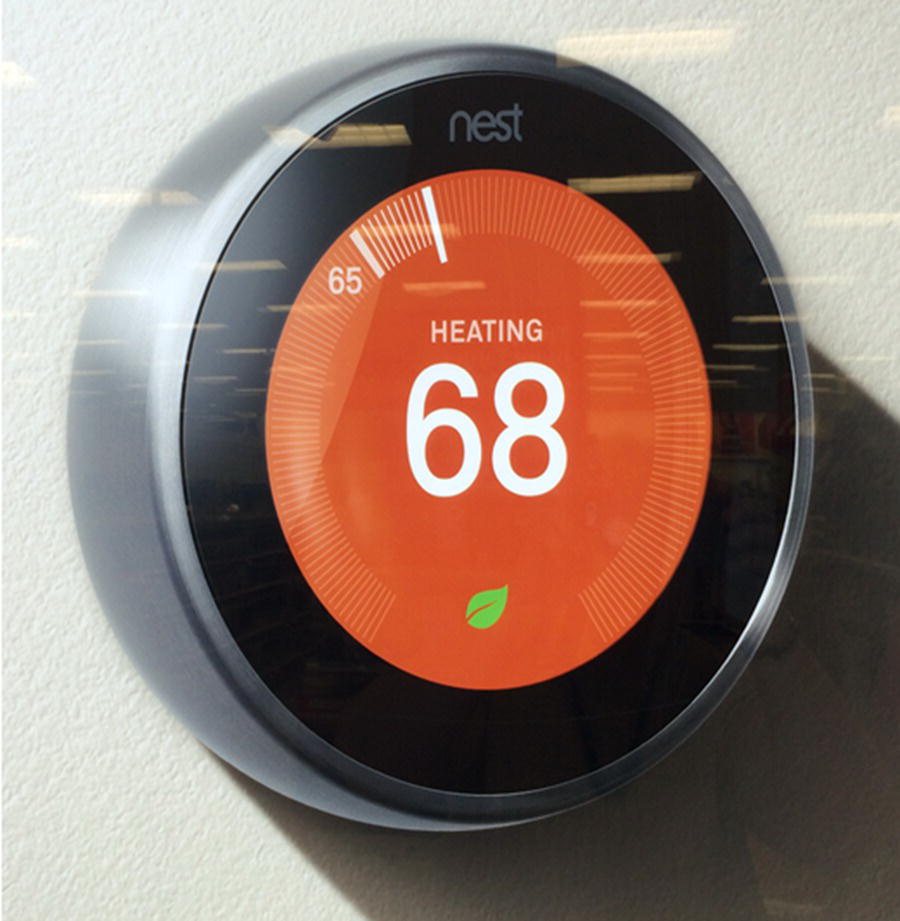
Figure 1.11 Picture of a “NEST” thermostat for smart buildings and houses.
Photo by B. Prince.
In the future, sensors worn by individuals could communicate with the smart building’s environmental controls to permit individually temperature controlled workspaces. Individual track robots can bring requested materials to the user and individually prepared meals, for example, could be automatically delivered along the same tracks.
Air quality can be monitored on an ongoing basis to ensure high air quality to all residents. Local toxins can be sensed and isolated consistent with ensuring the safety of all inhabitants. In case of a fire, areas can be isolated automatically after checking for inhabitants. Sound can be monitored from all locations and information can be provided at each location. Sound systems can be maintained by location.
1.9.2 Smart Factories
The fully automated factory is also a reality today. Large semiconductor factories with fully automated assembly lines are operated by a few workers and maintenance staff along with sophisticated robotic machines capable of precise operations that can be programmed and the program modified remotely.
While automated factories have been around since the 1970s, fully interconnected smart factories are more recent. Both customer reliability and government reportability demand transparency and interaction during the various stages of the automated manufacturing process.
Automated monitors can generate data at every step. Smart vision monitors can replace inspectors on assembly lines. Safety can be improved by new touch interfaces with sensors to detect the presence of people. This has results in new generations of large robots with user‐friendly interfaces. This ranges from pick and place for very small objects and for very large objects. Real time information can be generated by connected machines around the world as industrial robots generate real time information for monitors and regulators.
Automated inspection robots can detect faults, replacing human inspectors, and can identify and report on these faults. Robots can self‐test and repair themselves. The motion and amount of force used can be adjusted automatically using vision systems during pick and place. Vision guided smart robots can pack boxes and sort random materials on a pallet in a warehouse. Materials can be transferred to smart carts for delivery and place in warehouses. These are all examples of smart machines talking with other smart machines.
An example is a phased semiconductor factory automation design developed by Hewlett‐Packard that permits a semiconductor factory to incorporate progressive levels of factory control software, as well as automated material handling systems and real time tool control [9].
Distributed stacking can be designed into a warehouse with manual contingency operations. Reliability considerations can be installed using in a phased approach. Three‐dimensional (3D) vision guided robots can handle random bins or mixed pallets in warehouses. Smart camera systems can inspect and report to machines staged further on in the process. Smart configurable machines can be programmed by incoming vision systems for the automated process required for multiple processes and can transmit the requirements to the appropriate machine. Varying reliability requirements can be implemented and inspected in a smart factory according to user requirements by machines programming other machines.
1.9.3 Intelligent Hospitals
Intelligent hospitals can intake physicians’ instructions, order prescriptions, automate incoming patient screening and tests, and include specialists in various fields in the individual diagnosis. Reliability monitors can check the remotely monitored individuals for procedure errors and make automated corrections. Sanitation detection measures can be implemented to prevent hospital‐generated diseases and patients can be routed to the areas best able to protect and care for them.
An illustration of possible features of a connected hospital is shown in Figure 1.12.

Figure 1.12 Illustration of digital connected systems in a smart hospital environment.
Advantech in Berlin, for example, configures smart hospitals in which nursing carts can deliver medications to patient rooms and deliver individualized medications [10]. Patient data management systems can automatically handle a large number of on‐line patient records and ongoing treatment systems. Mobile handheld clinical assistants can provide instant records to local medical staff. Patient feedback both from automated monitors and individually entered by each patient can provide a full picture of individual care. Individual room imaging systems can aid in diagnoses and provide expert opinions and diagnosis without the expert being required to be present in the room.
Safety checks can be programmed into the system to double‐check diagnoses, tests, and treatments to avoid errors. Automated background calibration systems can check instruments and automated redundant reliability systems can check for hospital errors in procedures. Digital badges can maintain a real time monitor location of each staff member to track, for example, communicable disease spread or establish medical decision chains. Digital badges for patients can monitor procedures and locations and check against prescribed procedures for that patient.
1.9.4 Smart Public Buildings
Public buildings are being networked to enhance their functions. Courthouses and Libraries are being linked to large information centers and extensive specialized sources. Museums have virtual representations that transport the viewer to distant and exotic scenes. Extensive safety networks are being developed to keep people safe in large public gatherings. In the future, virtual museums and virtual concert halls may bring the sights and sounds to the viewer, reducing the number of large public gatherings.
1.10 Thoughts
The intelligent connected world being described here is feasible and early implementation is already taking place around us. The rate of implementation of these technologies will be sporadic, but it is clear that the more useful applications are already finding a rapid rate of adoption in urban areas where the population density lends itself to observing the advantages more quickly. Automated and intelligent use of these extensive data connections will follow.
References
- 1 McGoogan, C. (2016) Amazon makes first drone delivery to house in Cambridge. The Daily Telegraph, 14 December 2016.
- 2 Aitken, R. et al. (2014) Device and technology implications of the Internet of Things (ARM), VLSI 2014, June 2014.
- 3 MiniMed 530G System featuring exclusive SmartGuard technology for advanced protection against lows. Medtronic website, professional.medtronicdiabetes.com/minimed‐530‐g, September 1, 2016.
- 4 Introducing the Dexcom G5 mobile CGM system, https://www.dexcom.com/.
- 5 The Animas Vibe insulin pump and CGM system, https://www.animas.com/diabetes‐insulin‐pump‐and‐blood‐glucose‐meter.
- 6 Kono, T. et al. (2014) 40‐nm embedded split‐gate MONOS (SG‐MONOS) Flash Macros for automotive with 160‐MHz random access for code and endurance over 10 M cycles for data at the junction temperature of 170 °C (Renesas). IEEE Journal of Solid‐State Circuits, 49 (1), 154, January 2014.
- 7 EZ tag. Wikipedia, 20 July 2016.
- 8 Singh, S. (2014) F‐RAM for smart E‐meters, Cypress Applications Note AN87352.
- 9 Gardner, D.C. (1996) Semiconductor factory automation: designing for phased automation, Hewlett‐Packard, Advanced Semi Man. Conference and Workshop, ASMC Proceedings, November 12, 1996.
- 10 Advantech digital healthcare smart hospital (PEIL), conhIT Berlin, December 2015.
